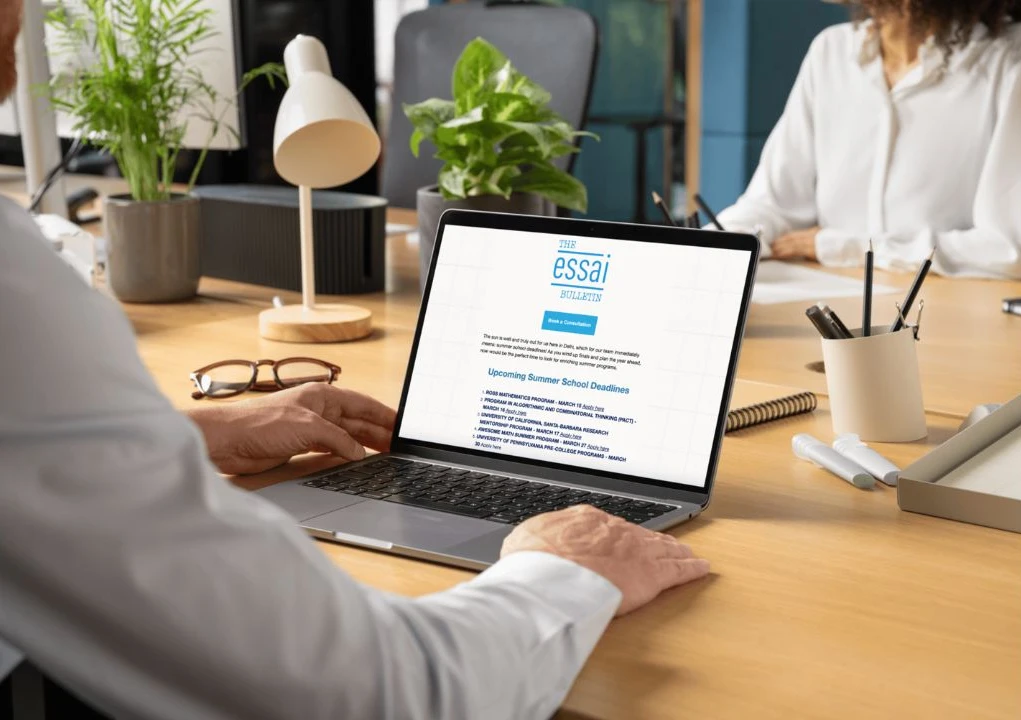Each year, thousands of high-achieving students open their college decision letters with trembling hands only to find themselves in limbo. Not rejected. Not accepted. Just… waitlisted.
In 2025, Ivy League waitlists have evolved into more than just a backup plan. They reflect a complex matrix of enrollment forecasting, institutional priorities, and applicant behavior.
Students who land here often have the qualifications to thrive on campus but are caught in the numbers game that Ivy League admissions has become.
The good news? Being waitlisted means you’re still in the game.
This guide is designed to help you understand what being on an Ivy League waitlist in 2025 really means. From decoding the process to actionable strategies and emotional support, we’ll help you stay informed and ready.
Whether you’re aiming to boost your odds or prepare a great Plan B, you’re not alone. With Essai and PIPPAMS, students can access the guidance they need to make the most intelligent possible decisions during this uncertain period.
How Ivy League Waitlists Work in 2025

The Ivy League schools, Harvard, Yale, Princeton, Columbia, UPenn, Dartmouth, Brown, and Cornell, continue to receive record-breaking application numbers in 2025.
With more students than ever applying to highly selective institutions, driven by test-optional policies, increased global access, and strategic application tools, the competition has never been fiercer.
Despite this influx, the total number of available seats in each freshman class remains relatively fixed due to housing limitations, faculty-student ratios, and long-term institutional planning.
This creates a growing gap between qualified applicants and available spots, enter the waitlist.
A Strategic Enrollment Tool
Waitlists give schools critical flexibility in shaping their final incoming class. If fewer accepted students enroll than anticipated, also known as a yield shortfall, colleges turn to their waitlist to fill the gaps.
This doesn’t happen randomly. Instead, admissions officers use advanced modeling tools and predictive analytics to determine exactly how many students to admit off the waitlist based on how closely they’re tracking to their yield targets.
In 2025, the waitlist serves less as a “second-tier” and more as a strategic holding zone for students who meet the academic and personal profile the school desires, but for whom there wasn’t room in the first wave.
Rather than a ranked list, most Ivy League schools maintain a flexible pool of highly qualified applicants that can be tapped as enrollment needs change. This allows them to balance variables like major selection, diversity, extracurricular strengths, and even full-pay versus financial aid needs.
Ultimately, being on an Ivy League waitlist in 2025 still places you among the top tier of applicants, even if you haven’t crossed the finish line just yet.
What’s Changed in 2025
- AI-Powered Yield Prediction: Many colleges now use AI tools to predict which accepted students will enroll. This makes their need for the waitlist more precise but not perfect.
- More Selective Movement: With higher yield from Early Decision rounds, fewer spots are left for Regular Decision and waitlisted applicants.
- Targeted Waitlist Offers: Colleges may prioritize underrepresented groups, specific majors, or geographic areas.
Still, if you’re on the list, it means they saw value in your profile, they just couldn’t make room yet. Want to know more about how Ivy League admissions officers think? Here’s an official guide to the detailed NACAC guide.
Common Misconceptions About the Waitlist
There are many myths surrounding waitlists, and clearing them up can empower you to make smarter choices. Here are some of the most common ones students and parents still believe in 2025.
Myth #1: Being Waitlisted Means You Weren’t Good Enough
This belief can seriously undermine your confidence. The reality is that Ivy League schools reject tens of thousands of perfectly qualified students. Being waitlisted usually means your academic and extracurricular profile was strong enough, but other institutional needs like department quotas or demographics played a role in the decision.
In fact, some admissions officers have said they would accept every waitlisted student if they had room.
Myth #2: You Can’t Do Anything About It
Another dangerous myth is that the waitlist is a static situation. Students who take initiative, especially those who craft thoughtful Letters of Continued Interest, often stand out. In some years, schools have admitted dozens of waitlisted students who submitted updates, while others who remained silent stayed on the list until the cycle ended.
For LOCI writing help and update strategy, Essai’s mentorship service offers one-on-one support from admissions experts.
Myth #3: Waitlisted = Equal Chances
Just because you’re on the waitlist doesn’t mean everyone on the list has the same shot. Some schools may favor students with intended majors in underrepresented departments, while others may use the list primarily to adjust gender balance or fill financial aid needs.
The Emotional Impact: Managing Hope and Uncertainty

Being waitlisted is like pressing pause on a dream. It often sparks a unique kind of stress, not finality, but indefinite suspense. Students are left wondering: Should I move on? Should I still hope?
The emotional toll can be heavier than an outright rejection because it prolongs the decision-making limbo. You’re caught between preparing for a future elsewhere and still holding out hope for your dream school.
It’s mentally and emotionally draining, not just for students, but also for their families who share in the uncertainty. This in-between state can affect motivation, self-esteem, and even academic focus during the final months of high school.
Understanding the Psychological Toll
The waitlist triggers a cascade of emotions: frustration, confusion, self-doubt, and comparison. Watching peers celebrate acceptances on social media while you’re stuck in limbo can be demoralizing.
The fear of being left behind or the feeling of not being “good enough” begins to creep in, even for students with outstanding academic records.
Families often feel unsure how to help, and the lack of clear timelines only makes things worse. Each day of silence can feel like a quiet rejection.
Many students report feeling isolated during this phase, especially if they’re the only one in their friend group who didn’t get a final decision.
Some begin to question their earlier achievements or their value as applicants, which can negatively affect their motivation during senior year. For high-achievers used to planning and progress, this period of uncertainty feels especially disorienting.
Support Is Key
This is where emotional coaching and strategic planning tools make a significant difference. Whether it’s talking to a trusted advisor, joining a support group, or working with a college admissions mentor, support shortens the emotional uncertainty. It reminds students that their journey is not a reflection of failure, but part of a larger story that’s still unfolding.
PIPPAMS offers reflection tools, progress tracking, and college planning insights that help students regain a sense of control, even in ambiguous situations. From comparing options to managing next steps, it equips students with clarity.
Essai pairs students with mentors who’ve been in their shoes, people who understand that admissions success isn’t linear and rejection doesn’t define your worth. With emotional validation and tactical advice, students feel seen, heard, and supported through every phase of their journey.
What You Can Still Do to Get In
While you can’t control institutional decisions, there’s still a lot you can do to improve your chances of getting off the Ivy League waitlist in 2025.
1. Accept the Waitlist Offer Promptly
Some schools ask you to opt in. Do this as soon as possible to demonstrate serious interest. If the school doesn’t require a response, still consider emailing the admissions office to reconfirm your continued enthusiasm.
2. Craft a Strong Letter of Continued Interest (LOCI)
This letter should reiterate your love for the school, provide specific reasons for your interest, and share new achievements since your original application. Don’t just repeat your Common App.
Essai’s essay consultants can help you fine-tune your message with precision and emotional depth.
3. Share New Achievements and Awards
New AP scores, GPA boosts, publications, awards, leadership roles, or community projects? All of these can reinforce your upward trajectory. Send an updated resume or a brief email outlining the highlights.
4. Consider a New Recommendation Letter
If allowed, a recent teacher or mentor can speak to your growth and maturity. Make sure it adds a fresh angle, not just repetition.
5. Demonstrate Continued Interest the Right Way
Don’t send daily emails, gifts, or gimmicks. Instead, focus on one or two meaningful updates between now and June. A short video, a project sample, or an academic milestone could be appropriate if relevant.
6. Build a Backup Plan You Love
Commit to another school with full excitement. Don’t treat it like a placeholder. Explore housing, join student groups, and connect with advisors. If the waitlist comes through great. But you’ll never regret preparing thoroughly for the next chapter.
PIPPAMS comparison tools help weigh multiple offers so you can feel confident and clear-headed no matter what happens.
How Platforms Like Essai and PIPPAMS Help
Today’s students don’t just need hope, they need structure. That’s what Essai and PIPPAMS deliver: personalized guidance and tools that help students think critically, act strategically, and stay emotionally grounded.
Essai’s Waitlist Support Services
Essai has helped students get off the waitlist at Ivy League and Top 20 schools for years. Their support includes:
- 1-on-1 Mentor Calls with Ivy League alumni
- LOCI Drafting & Editing to make your message powerful and polished
- Strategic Review of updates and supporting documents
- Mental Health Check-ins during this uncertain stage
Learn more about how Essai’s personalized admissions mentorship empowers students in waitlist limbo.
How PIPPAMS Optimizes Planning
PIPPAMS supports schools and students with academic planning, extracurricular tracking, and offer comparison tools. For waitlisted students, it provides:
- Custom Dashboards to track waitlist deadlines
- Offer Matrixes to compare scholarships and benefits
- Advisor Tools to monitor student actions and follow-ups
- Resilience Tracking to ensure students don’t feel lost
Final Thoughts: Don’t Wait Passively, Wait Strategically
Being waitlisted by an Ivy League school in 2025 doesn’t mean your story is over. It means your story is evolving, and how you respond will shape the next chapter.
Rather than dwelling in uncertainty, use this time to:
- Reflect on how far you’ve come.
- Strengthen your narrative.
- Prepare confidently for what’s next, wherever it may be.
You’ve already shown incredible strength to get this far. Now, let your maturity, adaptability, and authenticity shine.
Still unsure what to send or how to write your LOCI? Get in touch with Essai today for expert guidance that meets you where you are and helps you move forward.
Frequently Asked Questions
Q1: What are the odds of getting off an Ivy League waitlist in 2025?
It ranges widely. Princeton may admit fewer than 1% of its waitlist, while UPenn or Cornell might admit up to 15–20% in some years. Odds vary by year, yield, and institutional needs.
Q2: Should I send another recommendation letter?
Only if the college allows it and if the new recommender offers a fresh, valuable perspective. Don’t send one just to check a box, make it count.
Q3: Can I appeal a waitlist decision?
Not formally. But a well-written LOCI is the best way to present new information and reaffirm your interest.
Q4: What if I get accepted after enrolling elsewhere?
You may still switch, but read the financial fine print. Some colleges won’t refund deposits or may limit housing choices.


